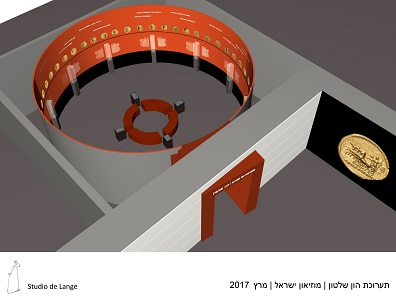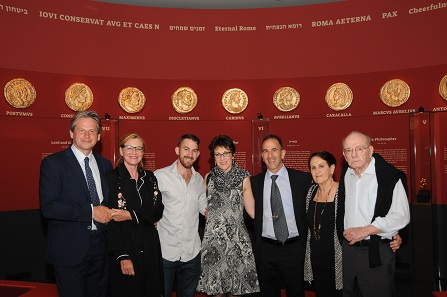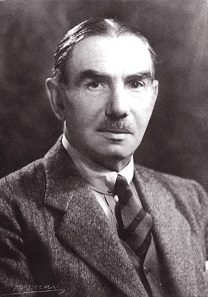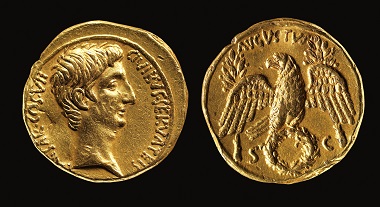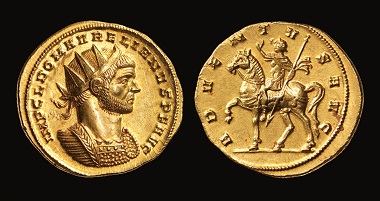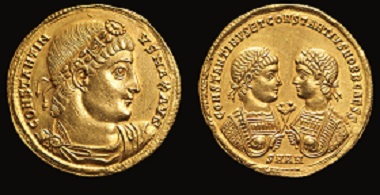by Haim Gitler
August 3, 2017 – The exhibition “Faces of Power. Roman Gold Coins from the Victor A. Adda Collection” at the Israel Museum displays 75 coins that Jackie Adda Coen donated as a tribute to a great collector and connoisseur, Victor A. Adda.
Facial features have been regarded as a reflection of character and ability since ancient times. In the days of the Roman Empire, emperors used their own images to deliver messages to the citizens of Rome. Since most of the population had no direct contact with the emperor, his portrait on coins was a means of identifying him and establishing a relationship with the people.
The exhibition shows 75 Roman gold coins from the Victor A. Adda Collection which have been donated to The Israel Museum.
These 75 eye-catching golden coins from Adda’s collection have never before been displayed to the public. Bearing the portraits of Roman emperors and their family members, these coins offer a rare glimpse into the world of the rulers of the Roman Empire, as well as revealing the great artistic skill involved in their creation and the use of the human face to reflect a person’s character, mostly as a means of propaganda.
A digital layout of the exhibition.
The earliest of the gold coins was struck in 45 BCE by Julius Caesar; the latest is from 326 CE and bears the likeness of Constantine the Great. Whether they depict the emperors as mature and experienced or as young and innovative, as philosophers, soldiers, or lords and masters, the portraits, together with the coins’ slogans touting victory, peace, or security, were meant to immortalize Rome and its rulers. When we look upon the faces of the past it’s like navigating through history.
Photo from the opening night of “Faces of Power”. From left to right, Prof. François de Callatay and his wife Hannah, Stav Gitler, Ronit Gitler, Haim Gitler, and Haim’s parents Beky and Carlos Gitler.
However, none of these faces can be taken at face value (so to speak) because no portrait is as simple as it may seem. Every portrait is a result of a three-way contest: first of all there is the vanity of the emperor, how he thought he would like to be seen. Then there is the job of the die engraver who complicates that vanity and last but not least, how you, the public, responds to it – each one differently – and it is this three-way game which gives the portraits their complexity their richness and their intrigue. Examining these portraits and getting to know the stories of these emperors they represent is to understand not only how portraits were created but how Rome was created. Looking at these portraits you will find yourself scanning the world for connections and making snap judgments: friend or foe, cruel or kind. As we gaze upon them here today, we are living proof of their success.
Victor Adda.
The exhibition is a tribute to the great collector Victor Adda, born in Alexandria, Egypt, in 1885. The coins on display are a gift to the Israel Museum by his daughter, Giovanna Adda Coen.
How it all began
On the morning of December 24, 2013, I had the pleasure of meeting Ester Coen at The Israel Museum. It was during our meeting that I heard a fantastic story about the legendary Victor A. Adda collection and was amazed to learn that Ester’s mother had asked her to check into the possibility of donating part of the Roman gold coins from this collection to the museum. Soon after, I went to Rome and met one of the loveliest persons I have ever known, Giovanna (Jackie) Adda Coen, one of Victor Adda’s four daughters.
Jackie was thrilled from the beginning with the idea that some of her father’s stunning Roman gold coins would become part of the Israel Museum’s collection, as almost 50 years earlier, just after the museum’s grand opening in 1965, her mother had donated several important antique objects in honor of her late husband.
The catalogue
In conjunction with the exhibition we published a book with the same name as that of the exhibition. The content of this book is a result of numerous discussions I had with Jackie and our mutual interest in bringing together a group of specialists on Roman numismatics to contribute from their knowledge in order to produce an extensive work that covers the periods to which the 75 gold coins date. This publication is a result of the work of 17 devoted scholars who are first of all my friends. I would like to express my deepest gratitude to each one of them.
Aureus of Augustus, 27 BCE.
Victor A. Adda’s story
The book begins with a personal touch, the life story of Victor A. Adda in Jackie’s own words. This lovely text takes us back to Alexandria at the turn of the twentieth century.
Arturo Russo, to whom we are ever indebted for funding and publishing this volume, describes the Adda collection in context, as one of the century’s major collections of Roman gold coins. The collection consists of just over 1,000 coins, of which the main nucleus is Roman: 761 aurei and solidi covering a period from Julius Caesar to Romulus Augustulus, from the last years of the republic to the end of the empire. Side by side with Roman coins, the Adda collection also included 38 Byzantine gold coins; 65 Bosporus staters; 28 Greek pieces and the 11 issues (+ one small cake ingot) of the renowned Delta hoard.
Aureus of Geta, 207 CE.
The attractive selection of 106 Egyptian coins begins with a beautiful Nectenebo II stater depicting a bridled horse and two hieroglyphs: collar with six beads (nwb = gold), heart and windpipe (nfr = good). It is followed by an impressive selection of Ptolemaic gold and silver issues, which culminated with Cleopatra at Ascalon. Catharine Lorber, a leading expert on Ptolemaic coins and one of my dearest friends, commented the following on this section of the collection: “The greatest rarity that should be pointed out, even more than the wonderful Cleopatra tetradrachm of Ascalon, is a unique mnaieion depicting the radiate Ptolemy V (without the spear), dated to year 6. Also important and worth mentioning are two extremely rare portrait mnaieia of Arsinoe III, one from Alexandria and the other from a Syro-Phoenician mint, and a tetradrachm and didrachm of Paphos depicting Ptolemy VIII with a radiate diadem and wearing the aegis like a chlamys. These varieties are the only coin portraits of Arsinoe III and Ptolemy VIII and accordingly the only reliable evidence we have for their appearance. Overall, I would observe that the Ptolemaic collection favors gold over silver and is especially strong in third-century issues, no doubt reflecting Victor A. Adda’s ability to acquire coins from the Benha hoard of 1936 (IGCH 1694). Adda made a point of collecting unpublished varieties, especially of mnaieia in the name of Arsinoe Philadelphus, and very rare small denominations like the half mnaieion depicting the radiate Ptolemy III and the quarter mnaieion of the K-series Arsinoes. One can observe that he was interested in style, favoring coins of beautiful style but also ensuring that his collection included a range of attractive or interesting styles, especially in the portraiture of Arsinoe Philadelphus. It’s obvious that Victor A. Adda was extremely knowledgeable about Ptolemaic gold coinage, and that he possessed exquisite taste”.
Aureus of Aurelianus, 274 CE.
A selection of 16 pages of Victor’s Adda’s handwritten French catalogue are illustrated along with scannings of the plates of the entire Victor A. Adda collection, which appeared in a private catalogue produced by Christie’s in 1986 for the family of which only 24 copies exist (part of the Victor A. Adda collection was sold in two Christie’s auctions in 1984 and 1985).
A brief introduction about the aureus as the premier coin in the Roman monetary economy is followed by papers written by 14 scholars, covering a period of more than 300 years, from the end of the republic (first century BCE) to the beginning of the fourth century CE (Richard Abdy, Michel Amandry, Roger Bland, Andrew Burnett, Aleksander Bursche, Gil Gambash, Cristian Gazdac, Haim Gitler, Achim Lichtenberger, Jerome Mairat, Rodolfo Martini, Markus Peter, Johan van Heesch, Bernhard E. Woytek). These papers focus on crucial developments during the Golden Age of the Roman Empire as reflected by the Adda coins.
Solidus of Constantinus I and his cons. 326 CE.
How to analyse portraits of Roman emperors
In a comprehensive overview of this volume, Matti Fischer outlines a framework for analysis of the Roman emperors’ portraits themselves. This includes the use of art-historical methods such as analysis of the frame, composition, the physiognomy, the iconography of the bust and face and meanings inherent in the use of style, and the special type of production and distribution unique to coins. He provides insights into the meaning of identity and value while projecting new concepts relevant to research both of ancient coins and of modern uses of the face.
Yaniv Schauer, co-curator of the exhibition, prepared with the help of Jonathan Grimaldi from NAC an extensive catalogue of 611 of 1,012 coins from the original collection that are dated to the period under discussion. This catalogue includes valuable information on the provenance of those specimens that Victor Adda purchased on the antiquities market.
I would like to thank my dear friend Gil Gambash for co-editing this volume and for his most productive insights during our dialogues about the exhibition.
The exhibition will run through June 2018.
To learn more about the exhibition go to the Museum’s website.






